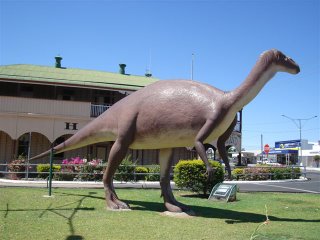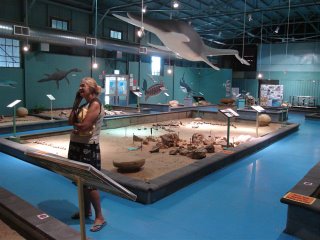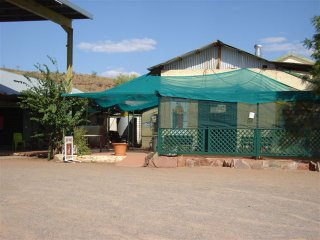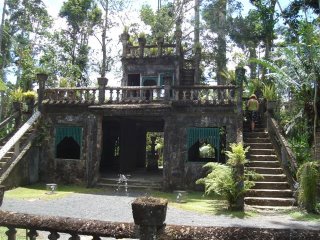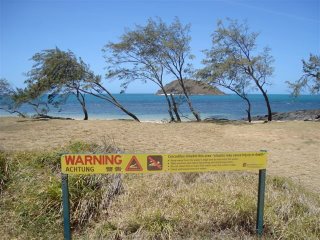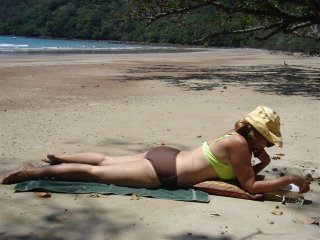Bees were also feeling the heat as by late afternoon the bucket that catches our waste water from the kitchen sink had attracted what appeared to be the entire hive! Feeling rather like Keith and Colleen in their film Snake Killers of the Kalahari when the wet towels they used to keep themselves cool attracted swarms of bees, our wet costumes had a similar effect. As for the bush-flies – they were out in full force using us to keep out of the hot wind. Turning away from the wind only made it worse because then they would try to keep cool up our noses and behind our “sunnies” and we didn’t dare speak! Fortunately by late evening cloud had moved in and the hot winds disappeared but the flies and bees continued to hum around Getaway until night fell around eight o’clock.

Quagi Beach
The bees woke us early next morning and overcast skies gave lie to yesterday’s heat. A good day to travel and we moved on to Munglinup Beach. Just as the Zulus use Kwa meaning “place of” so the Aborigines attach “… up”. Consequently, as we travel through this part of Western Australia many town names end in “.. up” derived from Aboriginal names. Like Quagi Beach campsite, Munglinup Beach site was also Shire run. Graders were re-surfacing the dirt road in, in readiness for Christmas and we were the first to travel the newly smoothed road and found we had the camp to ourselves. The dense cloud cover stayed with us for the rest of the day turning our turquoise blue seas into a mixture of deep green tones. The steep profile of the beach made walking difficult as we made our way to the mouth of the Munglinup Inlet that we followed a quad track along the crest of the fore-dunes and were dismayed to discover a hidden labyrinth of “quad heaven” with little regard to the sensitivity of the environment.
The dawn of another grey day pushed us on to sunnier climes, not that we counted on that from our past experiences of this region. The Southern Ocean is renowned for the cold fronts that it generates across here.
Approaching Jerramungup the first sounds of insects ricocheting off the windscreen brought a smile to George’s face. Locusts? News headlines in Esperance had advised that a locust plague in the Mt Barker district was likely to sweep through the wheat belt. We’d pricked up our ears as we were booked into Mt Barker after Christmas. Before long we were in no doubt as we passed through blitzes of flying grasshoppers. Birds of all sizes were dicing with death as they feasted on the ‘hoppers carpeting the road. We continued to encounter swarms right up to our bush camp in the Pallinup River Nature Reserve where, surprisingly, they weren’t at all intrusive. We did, however, get whiffs of something smelly, perhaps a dead kangaroo? Our evening walk took us down to the river and the closer we got the stronger it became. We were appalled to find our “smell” was emanating from stagnant pools within the rocky bed of the river. Lea felt quite overwhelmed by the noxiousness of it all and even more horrified when George pointed out that the gas bubbling up from the floor of the pools was hydrogen sulphide. A few months back we’d watched an ABC documentary on a new theory regarding an unsolved double murder in the 1960’s where a couple involved in an elicit affair had been found dead on the edge of a river. Nothing could account for their death at the time until all these years later a scientist proposed that they may have been overcome by the an up-welling of hydrogen sulphide from the polluted sediments of the river. To avoid having the same fate befall us we moved out of the designated camping area to a site downstream of the bridge where the greater volume of water had no smell. Nevertheless, this river has a severe water quality problem. The bridge carrying the main road turned out to be of interest while we were down in the odorous part of the river bed as it had been built entirely of timber, certainly not apparent when we had crossed it.
It began raining during the night and was still drizzling when we got up and left for Cape Riche campground, the access road giving us 18km of red, sticky mud to travel on. Two wet looking kangaroos met us at the gate and virtually led us into a lovely site overlooking a wide bay with the sound of waves whooshing on the beach just below us. After a warming cup of tea we donned our jerseys and walked westward along Shed beach, with sand so fine that it squeaked underfoot, onto a rocky headland where we were delighted to find a kangaroo and her big joey. From there we had a good view of Cheyne Island, a nature reserve that lies 1km offshore and is home to Fairy Penguins.

Western Grey Kangaroo on rocks at Cape Riche campground
Following a fisherman’s track through the heath we were bombarded by locusts flitting across our pathway. So they had reached here too! The next beach, Home beach, took us round to the Cheyne lagoon and up into rolling heath-covered hills which in the misty, damp weather seemed reminiscent of Scotland. Perhaps the Scottish couple, George and Grace Cheyne felt this affinity when they established a trading post here in 1839.
Grey weather followed us into our second day here. Just as we set off for an easterly walk along Schooner Beach a small group of kangaroos feeding on the coastal verge between our caravan and the beach, held us up as we curiously observed each other mere metres apart. Best was the little joey’s face and ungainly legs sticking out of his mothers’ pouch. We had to clamber over brightly coloured orangey-yellow rocks to get onto Schooner beach, a conservative 3km stretch of flat beach backed by sheer sandstone cliffs. There we discovered a lemming-like situation ... within the flotsam of the high water mark were thousands upon thousands of drowned locusts. This got us thinking of the food chain frenzy that has resulted from this plague and whether it spills over into the marine environment.
 Locusts washed up on HWM at Schooner beach
Locusts washed up on HWM at Schooner beach
On our return we had a break in the skies. Our green seas turned back to their beautiful mottled blues and we were able to enjoy the beach until the ultra-violet rays sent us back to the cover of Getaway.
On leaving Cape Riche we decided it had been our most aesthetically satisfying campground and if it hadn’t been for the restriction on dogs would have been perfect for our Christmas break. Confusingly, Cheyne’s Beach where we were to spend Christmas, was another 50km west and out of Cheyne Bay. Arriving very early, we set Getaway up on our site and drove on to the City of Albany (an hour away) to stock up for Christmas and send / collect emails. Parking was horrific and to our disbelief there were no internet cafes. A worse situation than Uluru! We dashed back to camp, full of excited anticipation for the arrival of Saxon, Paul and Harley dog. To add to the occasion the sun finally came out and we were able to distract ourselves in the waiting by getting all our laundry done and having a good scrub up after 5 days of a lick and a promise. Our youngest family arrived without us recognising them! Paul driving his mother’s brand new Commodore and towing his parent’s newly acquired pop-top caravan. The “belly” came first with much patting and feeling before we were able to help them settle in.

Quality time on Cheyne’s Beach
It was pot luck selecting Cheyne’s Beach Caravan Park. Disappointingly, we found it situated well back from the beach with no view of the sea which was a pity because it is a picturesque area with granite boulders balanced on peaks surrounded by a national park and a wide, flat sweeping beach that swoops eastwards for at least 20km. Christmas season means no choice. From our adjoining sites we have watched the park steadily fill up with families. Opposite us a particularly large site has five caravans and a marquee set up in a horseshoe with their vehicles closing the laager. Just behind us was a group of six young yuppies with their “boy’s toys” which includes their fancy vehicles, quad bikes, fishing tackle and surf skis. Kids playing cricket on the roadway; boats on trailers and tractors line the front end of the park and quads in general definitely rule. Our nights have been cold and the first parts of the day very “English” – grey and drizzly with cold winds blowing that campers are togged up in beanies, jumpers and jackets. Fortunately, between each passing “front” we get good bouts of sun around midday. Regardless, we happily enjoyed family time, leisurely brunches, exploration of beaches and a visit into the National Park on 4WD tracks. This, to the glee of Paul and Harley being bounced around Skiv but not the best thing to do with a seven month pregnant daughter!














